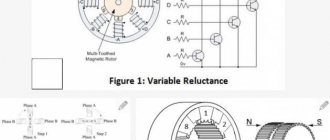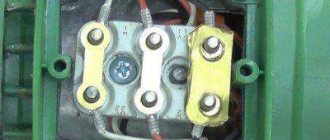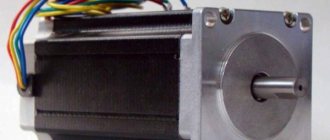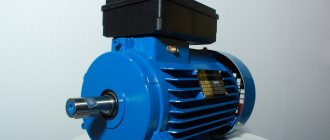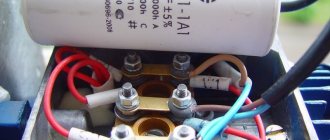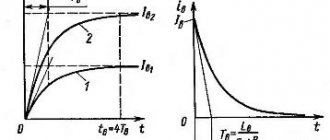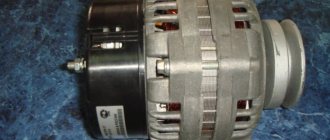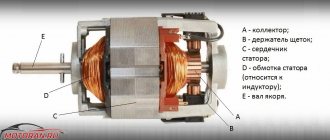Diagrams and recommendations for connecting an electric motor through a 220V capacitor
Most owners of private garages or workshops are faced with the question of how to connect a 380V electric motor to 220V through a capacitor or other methods.
Some types of equipment that may be privately owned, such as concrete mixers, grinders or woodworking machines, consume a lot of power. An asynchronous three-phase motor can provide it, but its main problem is that it is designed to connect to a 380V power network, which is absent or severely limited in most private households. We will consider options for getting out of the current 380/220 situation below.
Repair - how to connect the start button of a concrete mixer
The first place to start repairs is by inspecting the condition of the start button contacts.
To do this you need:
If the concrete mixer button no longer locks , and cleaning the contacts does not produce results, in most cases it requires a complete replacement. The asking price is 500-600 rubles.
Replacing the concrete mixer button is not particularly difficult, so you can do it yourself. First you need to purchase exactly the same button so that it fits neatly in the housing.
The replacement procedure is as follows:
VIDEO INSTRUCTIONS » alt=»»>
To avoid such breakdowns in the future, you should operate the concrete mixer in strict accordance with the manufacturer’s recommendations.
After each use, the solution container must be washed, since the resulting build-up of hardened concrete increases the load on the engine.
Avoid getting water on electrical equipment (do not use the stirrer during rain). You should also avoid excessive loads on the unit - periodically you need to take breaks from work.
Difference between single-phase and three-phase units
Before you begin to directly examine the connection diagrams of type 380/220, you need to understand the following:
Since most asynchronous electric motors are three-phase (380V), let’s start with them. Any such unit has two key elements: a movable rotor connected to the drive shaft, and a stationary ring-shaped stator. Each of them has phase windings offset relative to each other by 120º. The operating principle of a 380V motor is to create a moving (rotating) magnetic field. It is created in the stator windings when voltage is applied to them. Due to the difference in the frequencies of the rotor and stator fields, an EMF arises between the contact windings, which causes the shaft to rotate. The terminals of such a motor must receive three phases (220 V each) through a star or delta connection.
It is customary to call a single-phase power unit designed for connection to an identical, most often 220V household network. Considering that any such cable has two cores (phase and neutral), it is enough for the motor to have only one phase winding. In fact, the stator has two windings, but one is used as a working winding, and the second is a starting winding. In order for a 220V motor to start working, that is, for a rotating magnetic field to arise followed by an EMF, it is necessary to use both circuits. In this case, the starting winding is connected through an intermediate capacitive/inductive circuit or is closed if the power of the unit is low.
As you can conclude, the main difference between these two classes of motors (220 and 380 V) is not so much in the number of phases/connection wires, but in the organization of the start.
Connecting a single-phase motor via a capacitor - 3 circuits
What happens with this?
If the heating is quite noticeable, then you need to look for its causes. If the capacity is significantly exceeded, intense heating will begin.
It is necessary that the rated voltage of the capacitor is equal to or greater than the calculated one. This is the optimal solution for achieving average performance. Afterwards it is turned off by a special device - a centrifugal switch or a start-up relay in refrigerators.
Secondly, and most importantly, the author was convinced in practice that even an extremely accurate calculation is not a guarantee of the correct operation of the engine. One of the windings is connected directly to the network, and the second is connected using a capacitor. In the geometric dimension, the windings in the stator are placed opposite each other. So, step by step, we figured out how to connect a three-phase asynchronous electric motor to a single-phase network and what you need to calculate and know for this.
Asynchronous or collector: how to distinguish
Two of them are stator structural elements connected in parallel. Based on the maximum current flowing through it, a magnetic starter belongs to one of seven standardized groups. In fact, the launcher only works for seconds. As a rule, the resistance of the windings will be no more than several tens of ohms.
For example, on the operating conditions of the engine itself, on the connection diagram, on the capacitors, or, more precisely, on their capacity. For this purpose, the circuit provides for the presence of a special button designed to open the contacts after the rotor reaches a given speed level. Another example when measurements can show 10 ohms, 10 ohms, 20 ohms.
When you need to quickly spin up the engine, a circuit with a starting capacitor is used. It makes no difference what kind of working winding you have and what kind of starting winding. For single-phase asynchronous AC motors with a running capacitor, the auxiliary winding is permanently connected through a capacitor. But in any case, losses will range from 30 to 50 percent.
The most common motors of this type can be divided into two groups: single-phase motors with a starting winding and motors with a running capacitor. She's in the second picture. Connect a three-phase motor to a single-phase network. Starting and running capacitors.
Source
Features and methods of connecting to a single-phase network
A single-phase current of 220V supplied to the electric motor, more precisely to its stator and rotor, forms two equal magnetic fields rotating in opposite directions. In order to make the rotor rotate, you need to manually or through starting devices organize a phase shift. The power will be below rated (50...70%), but the engine will work.
Obviously, by directly connecting one of the phase windings to a 220V network while the others are not working, it will not be possible to start the engine. Therefore, all three phases need to be connected through an intermediate circuit. You can do this in two main ways:
Sometimes even mechanical rotation of the rotor is enough to make a 380 engine start from 220.
General diagrams for connecting motors from 380V to 220V via a capacitor
Most often, when it is necessary to solve such a problem, working and starting capacitors (capacitor banks) are used. Basic 380V delta and star connection diagrams can be seen in the following illustration:
The non-fixed "Acceleration" button is used to activate a parallel-connected starting capacitor. It must be held until the engine reaches maximum speed. After this, the starting circuit must be disconnected to prevent overheating of the windings. If the engine power is low, the starting capacitor can be neglected, working only through the working capacitor.
Capacitor capacitance is calculated using the following formulas:
The capacity of the starting capacitor should be twice as high as the working one. If you do not resort to calculations using formulas, you can use the value 7 µF/kW.
Practical application shows that a triangle connection is more effective, since in this case the voltage distribution in the windings will be more uniform, and the power will be reduced less. There is however one limitation, which concerns the layout of the motor terminal block. If under its cover there are only three 380 pins, then there is a preset connection diagram that cannot be changed. If there are six pins there, then you can choose which option to organize. The characteristic designation is applied to a metal plate with characteristics.
If a 380-volt motor is supposed to be used at 220V in a mode with frequent starts and stops, then the basic circuit can be modified to organize a dynamic braking circuit:
Selection of capacitor for a three-phase motor
The selection of the capacity of the working capacitor for a three-phase motor is carried out according to the following formula: Work = k*Iph / U network
.
- k
is a coefficient, the value of which depends on the connection diagram of the three-phase electric motor. 4800 in the "triangle" pattern and 2800 in the "star" pattern; - Iph
- indicates the rated stator current. You can find out the rated stator current on the motor housing or using special pliers; - U network
- mains voltage 220 volts.
Knowing all of the above parameters, you can accurately calculate the capacity of the working capacitor in microfarads for the electric motor. There is an easier way to calculate the capacitance of capacitors. The rule applies here: for 100 W of engine power, take approximately 7 µF of capacitor capacitance.
The situation is completely different with the selection of a starting capacitor for an electric motor. The starting capacitor operates for a very short time, only about 3 seconds. at the moment of starting the engine. The main task of the starting capacitor is to bring the rotor to the nominal speed level.
Connect the 380 motor to 220 V through capacitors and without capacitors.
In the article you will learn how you can connect a 380 motor to 220 V. In a household network, the voltage is single-phase 220 V. And most asynchronous motors are designed for 380 V and three phases. And when making homemade drilling machines, concrete mixers, emery machines and others, it becomes necessary to use a powerful drive. A motor from an angle grinder, for example, cannot be used - it has a lot of revolutions and little power, so you have to use mechanical gearboxes, which complicate the design.
Connection diagram for a three-phase motor via a capacitor
Here, the voltage of 220 volts is distributed into 2 series-connected windings, where each is designed for this voltage. Therefore, the power is lost almost twice, but such an engine can be used in many low-power devices.
The maximum power of a 380 V motor in a 220 V network can be achieved using a delta connection. In addition to minimal power losses, the engine speed also remains unchanged. Here, each winding is used for its own operating voltage, hence the power.
It is important to remember: three-phase electric motors have higher efficiency than single-phase 220 V motors. Therefore, if there is a 380 V input, be sure to connect to it - this will ensure more stable and economical operation of the devices. To start the motor, you will not need various starters and windings, because a rotating magnetic field appears in the stator immediately after connecting to a 380 V network.
Design features of asynchronous three-phase motors
Asynchronous AC machines are a godsend for any owner. It’s just that connecting them to a household network turns out to be problematic. But you can still find a suitable option, the use of which will result in minimal power losses.
Before connecting a 380 to 220 motor, you need to understand its design. It consists of the following elements:
There must be a metal nameplate on the engine - all the parameters are written on it, even the year of manufacture. The wires from the stator go into the terminal box. Using three jumpers, all wires are connected to each other. Now let's look at what motor connection diagrams exist.
Star connection
Each winding has a beginning and an end. Before you connect a 380 to 220 motor, you need to find out where the ends of the windings are. To make a star connection, it is enough to install jumpers so that all ends are closed. Three phases must be connected to the beginning of the windings. When starting the engine from a three-phase network, it is advisable to use this particular circuit, since high currents are not induced during operation.
But it is unlikely that it will be possible to achieve high power, so hybrid circuits are used in practice. The motor is started with the windings turned on in a star configuration, and when it reaches a stable mode, it switches to a delta configuration.
Connection diagram for delta windings
The disadvantage of using such a circuit in a three-phase network is that large currents are induced in the windings and wires. This leads to damage to electrical equipment. But when working on a 220 V household network, no such problems are observed. And if you are thinking about how to connect a 380 to 220 V asynchronous motor, then the answer is obvious - only by using a delta circuit. In order to make a connection according to this scheme, you need to connect the beginning of each winding to the end of the previous one. Power must be connected to the vertices of the resulting triangle.
220 Concrete Mixer Motor Connection Diagram
- LaStroy Posted on 08/14/2018Concrete mixersNo Comments
How to connect an asynchronous motor to a voltage of 220 V
Since the supply voltages for different consumers may differ from each other, it becomes necessary to reconnect the electrical equipment. Connecting an asynchronous motor with a voltage of 220 volts for further operation of the equipment is quite simple if you follow the suggested instructions.
This is actually not an easy task. In short, then we only need to connect the windings correctly. There are two main types of asynchronous motors: three-phase wye-delta motors and motors with a starter winding (single-phase). The latter are used, for example, in Soviet-design washing machines. Their model. ABE-071-4S. Let's look at each option in turn.
- Three-phase
- Switch to desired voltage
- Voltage increase
- Voltage reduction
Connecting the motor using a frequency converter
This method is at the same time the simplest, most progressive and expensive. Although, if you need the functionality of an electric drive, you won't regret any money. The cost of the simplest frequency converter is about 6,000 rubles. But with its help it will not be difficult to connect a 380 V motor to 220 V. But you need to choose the right model. Firstly, you need to pay attention to which network the device is allowed to connect to. Secondly, pay attention to how many outputs it has.
Using capacitors
When using a motor with a power of up to 1500 W, you can install only one capacitor - a working one. To calculate its power, use the formula:
I – operating current, U – voltage, P – engine power.
To simplify the calculation, you can do it differently - for every 100 W of power, 7 μF of capacitance is needed. Therefore, for a 750W motor you need 52-55uF (you need to experiment a bit to get the right phase shift).
In the event that a capacitor of the required capacity is not available, you need to connect in parallel those that are available, using the following formula:
A starting capacitor is required when using motors whose power exceeds 1.5 kW. The starting capacitor works only in the first seconds of switching on to give a “push” to the rotor. It is turned on via a button parallel to the working one. In other words, it causes a stronger phase shift. This is the only way to connect a 380 to 220 motor through capacitors.
The essence of using a working capacitor is to obtain the third phase. The first two are zero and phase, which is already in the network. There should be no problems connecting the motor; the most important thing is to hide the capacitors away, preferably in a sealed, strong case. If the element fails, it may explode and harm others. The capacitor voltage must be at least 400 V.
Is it possible to remove the start button on a concrete mixer?
If there is no new button, and you urgently need to start the concrete mixer, you can connect the concrete mixer without a button .
As a temporary measure, you can close the contacts directly, bypassing the coil, and turn the concrete mixer on/off by plugging/unplugging the plug from the socket, but this is not recommended, as this can lead to failure of the expensive electric motor.
Instead of a button, you can also temporarily install a regular circuit breaker, which will protect the engine from burning out in the event of jamming.
According to some experts, a 10-amp machine is suitable for these purposes.
Useful information about blocks, mixtures and additives in concrete
Useful information about blocks, mixtures and additives in concrete
Connection without capacitors
But you can connect a 380 to 220 motor without capacitors; you don’t even have to buy a frequency converter for this. All you have to do is rummage around in the garage and find a few main components:
You will also need capacitors, resistors (fixed and one variable), and a zener diode. The entire structure is enclosed in a housing that can protect against electric shock. The elements used in the design must operate at voltages up to 300 V and currents up to 10 A.
It is possible to carry out both mounted and printed mounting. In the second case, you will need foil material and the ability to work with it. Please note that domestic thyristors of the KU202N type get very hot, especially if the drive power is over 0.75 kW. Therefore, install the elements on aluminum radiators; if necessary, use additional airflow.
Now you know how to independently connect a 380 motor to a 220 motor (into a household network). There is nothing complicated about this, there are many options, so you can choose the most suitable one for a specific purpose. But it’s better to spend money once and purchase a frequency converter; it increases the number of drive functions many times.
Source
Repair - how to connect the start button of a concrete mixer
The first place to start repairs is by inspecting the condition of the start button contacts.
To do this you need:
If the concrete mixer button no longer locks , and cleaning the contacts does not produce results, in most cases it requires a complete replacement. The asking price is 500-600 rubles.
Replacing the concrete mixer button is not particularly difficult, so you can do it yourself. First you need to purchase exactly the same button so that it fits neatly in the housing.
The replacement procedure is as follows:
To avoid such breakdowns in the future, you should operate the concrete mixer in strict accordance with the manufacturer’s recommendations.
After each use, the solution container must be washed, since the resulting build-up of hardened concrete increases the load on the engine.
Avoid getting water on electrical equipment (do not use the stirrer during rain). You should also avoid excessive loads on the unit - periodically you need to take breaks from work.
General rules
Before switching on, be sure to check the voltage value for which the electric motor is designed - if you connect a potential difference greater than the specified one, the windings will overheat; if it is low, it will not start.
As a rule, on asynchronous machines two parameters are specified at once, less often only one:
The rating is determined together with the winding connection diagram - star or triangle. In the first case, the windings have a common point, and the phase wires are connected to the other three terminals of the coils. In the second, the end of one winding is connected to the beginning of the next in such a way that a closed circuit is formed. Some units are turned on only by a star, others by a triangle, and some can be independently connected in any of the ways; both characteristics are indicated on the nameplate of the electric motor.
For a triangle, the smaller voltage is used, and for a star, the larger of the two indicated. The difference is that three-phase motors connected in a star will have a soft start, while a delta motor can produce more power.
However, it will not be possible to achieve a full voltage shift in the stator windings. Although the rated voltage is supplied to the electric motor, the efficiency will be only 30 - 50%, which will be determined by the connection diagram of the windings of the asynchronous electric motor.
Do not turn on the electric motor without load. Since it is not designed for such a mode, the electric machine will quickly fail. Minimize idling as much as possible.
How to select capacitors?
If you are planning to connect an electric motor, then the choice of capacitor is carried out according to the following principles:
Table: determination of capacitor capacity
If the power you need is not in the table, you can use the calculation formulas:
Serb = (2800*I)/U - to turn on a three-phase motor with a star
Crab = (4800*I)/U - to turn on a three-phase motor with a triangle
where I is the amount of current flowing through the windings of the electric motor, and U is the network voltage. To find out the capacity of the starting capacitor for connecting a three-phase unit, you need to multiply the resulting working value by two.
